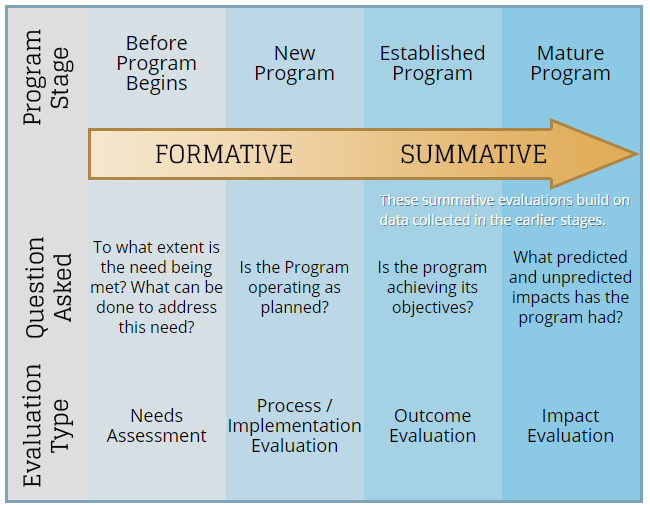Here you find a summary of considerations about evaluation in general. Aditionnaly there is a list of items that should be checked to find out, if your course followes the VTT-Box concept (and methodology).
Checklist for VTT-Box concept-based courses: Is my course following the VTT-Box-concept?![]()
Course evaluation
The course evaluations should preferably follow the design of the course design and the course execution. Accordingly, the course evaluations should be expressed strategically already during the conception of the course. Firstly, the objectives of the evaluations must be clearly and consciously formulated. Second, course evaluations can and should be carried out in different steps and schedules. The course evaluations can be carried out directly after the course or after the completion of the module. Course evaluations can also be carried out after some time to get feedback if the content of the course and/or module has been put into practice by the learners. Both perspectives are important and of value for the further improvement of a course. The first alternative, to do the course evaluation directly after the course or module, is usually to get spontaneous reactions from the learners and to have the possibility to make adjustments and improvements for the next course or module based on the feedback and needs of the learners. The latter alternative, relate and aim more to measure and receive feedback regarding the course or impact of the modules for learners and how it relates to activities and/or competences in working life and/or in life.
So it has to be clearly expressed from the very beginning What is purpose of evaluation?
Most often evaluation refers to a process that critically examines a program. It involves collecting and analyzing information about a program’s activities, characteristics, and outcomes. Its purpose is to make judgments about a program, to improve its effectiveness, and/or to inform programming decisions (Patton, 1987). Experts stress that evaluation can:
Improve program design and implementation.
It is important to regularly evaluate and adjust your activities to ensure that they are as effective as possible. The evaluation can help you to identify improvement potentials and ultimately help to realize your goals more efficiently. In addition, if you share your results about what has been less and less effective, you are helping to drive environmental education forward.
Demonstrate the effects on the program.
With the evaluation you can prove the success or progress of your program. The information you collect enables you to better communicate the impact of your program to others, which is critical to public relations, employee morale, and attracting and retaining support from current and potential donors.
What type of evaluation should I conduct and when?
Evaluations can be divided into one of two broad categories: formative and summative. Formative evaluations are carried out during program development and implementation and are useful if you want guidance on how best to achieve your goals or improve your program. Summative evaluations should be conducted as soon as your programs are well established and tell you to what extent the program is achieving its goals.
Within the categories formative and summative there are different types of evaluation. Which of these ratings is most appropriate depends on the phase of your program:
Table: Type of evaluation (Source: Meera)
| TYPE OF EVALUATION | PURPOSE |
| Formative | |
| 1. Needs Assessment | Determines who needs the program, how great the need is, and what can be done to best meet the need. An EE needs assessment can help determine what audiences are not currently served by programs and provide insight into what characteristics new programs should have to meet these audiences’ needs.
For more information, Needs Assessment Training uses a practical training module to lead you through a series of interactive pages about needs assessment. |
| 2. Process or Implementation Evaluation | Examines the process of implementing the program and determines whether the program is operating as planned. Can be done continuously or as a one-time assessment. Results are used to improve the program. A process evaluation of an EE program may focus on the number and type of participants reached and/or determining how satisfied these individuals are with the program. |
| Summative | |
| 1. Outcome Evaluation | Investigates to what extent the program is achieving its outcomes. These outcomes are the short-term and medium-term changes in program participants that result directly from the program. For example, EE outcome evaluations may examine improvements in participants’ knowledge, skills, attitudes, intentions, or behaviors. |
| 2. Impact Evaluation | Determines any broader, longer-term changes that have occurred as a result of the program. These impacts are the net effects, typically on the entire school, community, organization, society, or environment. EE impact evaluations may focus on the educational, environmental quality, or human health impacts of EE programs. |
Hint: Make evaluation part of your program; don’t tack it on at the end!

Fig 1. Formative vs summative evaluations. Source: http://meera.snre.umich.edu/evaluation-what-it-and-why-do-it
What makes a good evaluation?
A well planned and carefully carried out evaluation will bring more benefits to all stakeholders than an evaluation that is hastily and retrospectively compiled. Although you may feel that you lack the time, resources and expertise to conduct an assessment, early learning of the assessment and careful planning will help you manage the process.
- Good evaluation is tailored to your program and builds on existing evaluation knowledge and resources.
- Good evaluation is inclusive.
- Good evaluation is honest.
- Good evaluation is replicable and its methods are as rigorous as circumstances allow.
Hints to build and support an evaluation system:
- Couple evaluation with strategic planning.
- Revisit and update your evaluation plan and logic model
- Build an evaluation culture
The VTT-BOX evaluation strategy
For evaluation of courses using the VTT concept the above general issues on evaluation should be followed. In addition the VTT-BOX concets on pedagogical concept, quality enhancement framework and the use of Mandala should be considered and integrated.